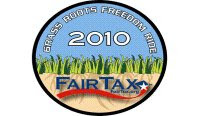I received the following e-mail from a fellow FairTax person. He was surfing through a blog written by someone that was at the machinist union meeting where Mike Huckabee spoke. This is not an endorsment for Mike Huckabee for President; however, I am endorsing anyone and everyone who advocates for the FairTax. The FairTax is a bi-partisan issue.
He said that the only topic discussed by the former governor was the Fair Tax. He said Huck asked union members to take a look at their paycheck stub and see how much they earned that pay period and compare that amount to how much they got to take home.
He reminded them that most of us have adjusted to living on that net amount at the bottom of the pay-stub. That we all think in terms of NET or TAKE-HOME pay instead of what we all really earn.
He told them that with the Fair Tax, the deductions for income and payroll taxes would disappear and that for many of them in that hall, they could anticipate raising their children and operating their household with a 30% to 50% increase in what they bring home.
He spoke of the new jobs that would be created and how competitive their industry would be in the global market when the embedded costs that income taxes add would no longer be a component of the cost of production.
According to someone who was there, it was just as much of a Fair Tax rally as it was a Huckabee rally... But not one media service reported what was actually said...
Subscribe to:
Post Comments (Atom)

2 comments:
Prices after FairTax passage would look similar to prices before FairTax - not "30% higher" as opponents contend - competition would see to it. So, the FairTax rate (figured as an income-tax-rate-non-comparative, sales tax) on new items would be 29.85% (on the new, reduced cost of items because business isn't taxed under FairTax - thus lowering retail prices by 20% to 30%), or 23% of the "tax inclusive" price tag - this is the way INCOME TAX is figured (parts of the total dollar).
The effective percentages, that different income groups would pay under the FairTax, are calculated by crediting the monthly "prebate" (advance rebate of projected tax on necessities) against all likely spending that citizen families (1-member and greater, Dept. of HHS poverty-level data) are likely to spend. (A single person would receive ~$200/mo. A family of four ~$500 - in addition to working members no longer having tax withholding confiscated from the fruits of their labor every two weeks.) Prof.'s Kotlikoff and Rapson (10/06) concluded,
"...the FairTax imposes much lower average taxes on working-age households than does the current system. The FairTax broadens the tax base from what is now primarily a system of labor income taxation to a system that taxes, albeit indirectly, both labor income and existing wealth. By including existing wealth in the effective tax base, much of which is owned by rich and middle-class elderly households, the FairTax is able to tax labor income at a lower effective rate and, thereby, lower the average lifetime tax rates facing working-age Americans.
"Consider, as an example, a single household age 30 earning $50,000. The household’s average tax rate under the current system is 21.1 percent. It’s 13.5 percent under the FairTax. Since the FairTax would preserve the purchasing power of Social Security benefits and also provide a tax rebate, older low-income workers who will live primarily or exclusively on Social Security would be better off. As an example, the average remaining lifetime tax rate for an age 60 married couple with $20,000 of earnings falls from its current value of 7.2 percent to -11.0 percent under the FairTax. As another example, compare the current 24.0 percent remaining lifetime average tax rate of a married age 45 couple with $100,000 in earnings to the 14.7 percent rate that arises under the FairTax."
Further, per Jokischa and Kotlikoff (circa 2006?) ...
"...once one moves to generations postdating the baby boomers there are positive welfare gains for all income groups in each cohort. Under a 23 percent FairTax policy, the poorest members of the generation born in 1990 enjoy a 13.5 percent welfare gain. Their middle-class and rich contemporaries experience 5 and 2 percent welfare gains, respectively. The welfare gains are largest for future generations. Take the cohort born in 2030. The poorest members of this cohort enjoy a huge 26 percent improvement in their well-being. For middle class members of this birth group, there's a 12 percent welfare gain. And for the richest members of the group, the gain is 5 percent."
IF:
Union workers want to see more of their hard earned money stay in their pocket
THEN:
They need to dump the union and the payments to the union bosses.
BTW - Voting against BIG GOVERNMENT tax increases by electing advocates of smaller government would help too.
Post a Comment